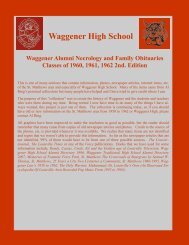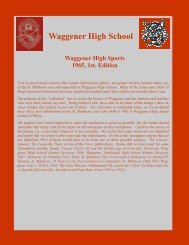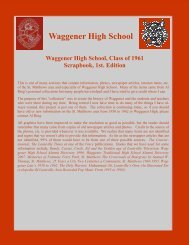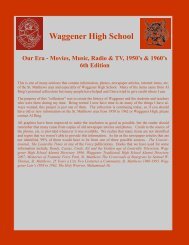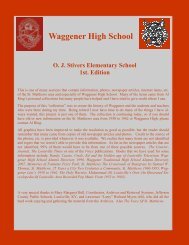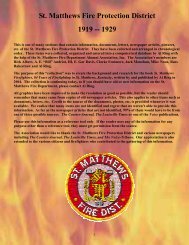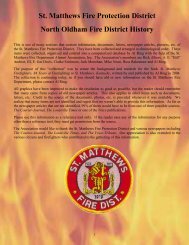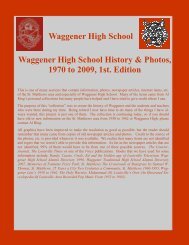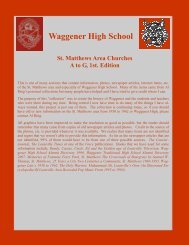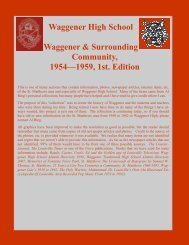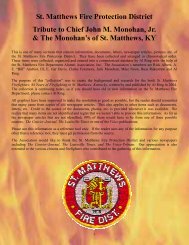The Voice of St. Matthews, January 2, 1958: New in 1957 almost a carbon copyNews in 1957 almost a carbon of former yearsSt. Matthews still into it with Louisville, more churches and schools were built, butsports scene was really outstanding(Article in very bad shape, many paragraphs missing or unreadable. Edited.)Although 1957 was a year of growth and progress in St. Matthews, the news reads almost like a carbon copy of formeryears.The City of St. Matthews was still tussling with Louisville, new churches, places of business and schools were going up,and the population was increasing.The City was still ruled by the same men who organized it seven years ago and in the smaller cities on its fringes, therewere still many familiar faces.By the end of the year, the St. Matthews business district still belonged to the City of St. Matthews, and the public was stillwaiting to see whether the Court of appeals could let St. Matthew keep it or turn it over to the City of Louisville.St. Matthews grew considerably in size as ordinances annexing stores, churches and other institutions along ShelbyvilleRoad, Browns Lane and Hubbards lane were passed.A move to incorporated Middletown failed, but another move to incorporate part of Lyndon seemed certain of success.The sixth class Cities of Broad Fields and Briarwood were incorporated.Several attempts to rezone major portions of the East end for <strong>com</strong>mercial and industrial use were made, the most conspicuousfailure being the request for rezoning of 524 acres near Lakeland to build a Reynolds Metals research center and plant.Residential building slowed down, but non-residential construction was high. John Walser finished a quarter million dollaroffice building on Westport Road, and the quarter-million-dollar Plantation Swimming club was open by July. The FairfaxBuilding was constructed on Frankfort Avenue by A. J. Eline, housing two stores, a dance studio and several offices.About $2,344,000 worth of new school buildings opened in December, including the Catholic Country Day school and twonew elementary schools, Shryock and Wilder.??? ??? Church buildings were ????, not counting a major expansion at Bethel E & R, and one of these, St. John Lutheran,was wrecked by a gas explosion and fire.In politics, St. Matthews remained Republican by a margin of more than nine to seven, while the rest of the County wasgoing democratic in the race for County-wide offices.The incumbent George Washington Party easily retained control of the six St. Matthews City council seats.The drama continued to flourish, as the Heritage Theatre, the St. Matthews Y Players and the St. Matthews CommunityTheatre maintained full and varied schedules.Two new fraternal organizations sprang into being the <strong>High</strong> Twelve club and the Elks.But most important to the youngsters here was the sports scene, and this formed one of the brightest chapters in the historyof St. Matthews for the year.The Eastern <strong>High</strong> Eagles <strong>com</strong>pleted the best season they ever had by winning the District and Regional Basketball titlesand going on to the finals of the State Tournament before they were beaten.The St. Matthews Merchants team won the Metropolitan Amateur Baseball Federation championship, and the Eastern <strong>High</strong>football team won the County championship. And finally, the Trinity <strong>High</strong> cross-country track team won the State championship.St. Matthews Little League ???? expanded from its two ???? ???? four teams each, to four team ???? 16 teams, and anAmerican Legion League was formed.Circuit Judge Lyne Smith electrified the <strong>com</strong>munity. At the beginning of June, he ruled that Louisville’s April 1 annexationof the St. Matthews business district was null and void on the grounds that Louisville was barred by the failure of the MallonPlan from annexing the area for five years.Under the Mallon Plan the previous November, Louisville attempted to annex the suburbs. The plan was defeated by thesuburban vote. According to State law, a City may not attempt to annex the same territory twice in five years.Louisville immediately took the case to the Court of Appeals and there the matter rested at the end of the year.
The Voice of St. Matthews, January 2, 1958: New in 1957 almost a carbon copyNews in 1957 almost a carbon of former yearsMeanwhile the City of St. Matthews continued its expansion. The City Council on January 8 gave first reading to two ordinancesproposing to annex an area on the south side of Shelbyville Road extending to Fairmeade.The area included 18 stores and professional offices, among them Pryor’s Restaurant, Landohr Bowling Alleys, andPendergrass Chevrolet.Also included were the St. Matthews Y.M.C.A., the Woman’s Club of St. Matthews the Kentucky Farm Bureau, and BeargrassChristian, Harvey Browne Memorial Presbyterian, and St. Matthews Methodist Churches.These annexations were <strong>com</strong>pleted in due time.Another important annexation was stopped, however, when residents of the area filed a remonstrance suit. The City Councilon June 4 had taken first steps to annex most of the unincorporated area between Browns Lane, the Innerbelt <strong>High</strong>way,and Shelbyville Road. The area to be annexed included the Shelbyville Road Plaza shopping center.The City <strong>com</strong>pleted another important action in April when it joined with the St. Matthews Business association to open afree municipal parking lot off Chenoweth Lane designed for ac<strong>com</strong>modation of 240 cars.And the City got a break from the Court of Appeals which ruled in February that the ordinance by which St. Mathews collected1954 taxes was valid. The Court reversed a ruling made in 1955 by Circuit Jude Macauley Smith. More than$50,000 in taxes were involved.The attempt to incorporate Middletown as a sixth class City was started in January but failed as the incorporators could notget the required number of registered voters to sign the petition.But the move to incorporate Lyndon, which started late in November, seemed more likely of success. The move wasprompted by a City-County Planning and Zoning Commission decision rezoning 18 acres on Leyton Avenue for industrialuse.The men behind the incorporation filed a suit in Circuit Court the first week in December to reverse the rezoning decision.Two new sixth class Cities were created here. They were Broad Fields and Briarwood.A petition was filed April 8 in Circuit Court for incorporation of Broad Fields as a City of 54 homes just southwest of St.Matthews. The incorporation was granted and the City held it first meeting May 31.Emil Maresz, of 3600 Graham Road, was elected Mayor and plans were made for annexation of the 30-some additionalhomes in the subdivision, not included in the original incorporation. The annexation was <strong>com</strong>pleted in July.Briarwood was incorporated in December, and Robert H. Davis, 31, of 2009 Japonica, was elected Mayor. The City is locatedoff Westport Road, just past the Children’s Center. There are 235 voters in the City.The incumbent George Washington Party had an easy time retaining the six St. Matthews City Council seats in the Novemberelection.They won by a majority of almost 3 to 1. Reelected were B. W. Gratzer, E. R. Grinstead, Henry Leathers, M. C. Rudy,Sam Rudy, and John Barker.Winners in Cherrywood for five trusted were Lucen Greene, Charles C. Myers, Rollo Fox, William Gladden and Evan A.Fraser.In Indian Hills, the incumbent Indian Party was reelected. Winning as trustees were R. Frank Gay, Henry D. Ormsby, Jr.,William B. Pirtle, W. R. Williamson, and William F. Lucas.On the County-wide level, St. Matthews was <strong>com</strong>pletely out of harmony with the rest of the County.While the Democratic ticket, headed by County Judge Bertram C. Van Arsdale, was sweeping back into office, St. Matthewswas going Republican by a margin of more that 9 to 7.St. Matthews vote wa the margin of victory for Republican Scott Miller in the Senate race against incumbent Arthur Grafton.The attempt to rezone 524 acres approved by the state at Lakeland for a Reynolds Metals plant and research center causeda tremendous debate not only in the East End, but throughout the <strong>com</strong>munity.Business interests were for it, particularly the Chamber of Commerce and the real estate men. Local labor unions also gobehind it on the hope of creating more jobs in the growing unemployment in the Falls City area.
- Page 2 and 3:
Explanation of the following pages,
- Page 4 and 5:
The Voice of St. Matthews, April 20
- Page 6 and 7:
The Voice of St. Matthews, April 20
- Page 8 and 9: The Voice of St. Matthews: July 17
- Page 10 and 11: The Voice of St. Matthews: Septembe
- Page 12 and 13: The Voice of St. Matthews, Septembe
- Page 14 and 15: The Voice of St. Matthews, Septembe
- Page 16 and 17: The Voice of St. Matthews, January
- Page 18 and 19: The Voice of St. Matthews, January
- Page 20 and 21: The Voice of St. Matthews:1955 Adve
- Page 22 and 23: The Voice of St. Matthews, May 5, 1
- Page 24 and 25: The Voice of St. Matthews, January
- Page 26 and 27: The Voice of St. Matthews, January
- Page 28 and 29: The Voice of St. Matthews, January
- Page 30 and 31: The Voice of St. Matthews, January
- Page 32 and 33: The Voice of St. Matthews, January
- Page 34 and 35: The Courier-Journal, October 20, 19
- Page 36 and 37: The Courier-Journal, October 20, 19
- Page 38 and 39: The Voice Of St. Matthews, January
- Page 40 and 41: The Voice Of St. Matthews, January
- Page 42 and 43: The Voice Of St. Matthews, January
- Page 44 and 45: The Voice Of St. Matthews, January
- Page 46 and 47: The Voice Of St. Matthews, January
- Page 48 and 49: The Voice Of St. Matthews, January
- Page 50 and 51: The Voice Of St. Matthews, February
- Page 52 and 53: The Voice Of St. Matthews, July 18,
- Page 54 and 55: The Voice of St. Matthews, August 1
- Page 56 and 57: The Voice of St. Matthews, August 1
- Page 60 and 61: The Voice of St. Matthews, January
- Page 62 and 63: The Voice of St. Matthews, January
- Page 64 and 65: The Voice of St. Matthews, January
- Page 66 and 67: The Voice of St. Matthews, January
- Page 68 and 69: The Voice of St. Matthews, January
- Page 70 and 71: The Voice of St. Matthews, January
- Page 72 and 73: The Voice of St. Matthews, April 2,
- Page 74 and 75: The Voice of St. Matthews, July 16,
- Page 76 and 77: The Voice of St. Matthews, July 16,
- Page 78 and 79: The Voice of St. Matthews, July 16,
- Page 80 and 81: The Voice of St. Matthews, July 16,
- Page 82 and 83: The Voice of St. Matthews, July 16,
- Page 84 and 85: The Voice of St. Matthews, July 16,
- Page 86 and 87: The Voice of St. Matthews, July 16,
- Page 88 and 89: The Voice-Jeffersonian, April 9, 19
- Page 90 and 91: The Voice-Jeffersonian, April 9, 19
- Page 92 and 93: The Voice-Jeffersonian, April 9, 19
- Page 94 and 95: The Voice-Jeffersonian, April 9, 19
- Page 96 and 97: Jim Herron Collection:L & N St. Mat
- Page 98 and 99: The Voice, July 25, 1974:Reading it
- Page 100 and 101: The Voice, July 25, 1974:25th Anniv
- Page 102 and 103: The Voice, July 25, 1974:falling li
- Page 104 and 105: The Voice, July 25, 1974:Under Ogle
- Page 106: The Voice, July 25, 1974:25th Anniv



